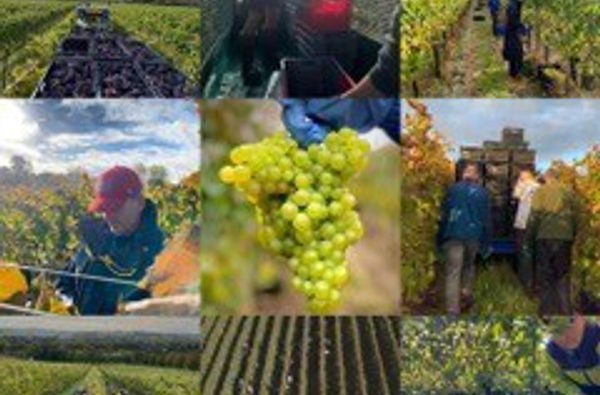Did you know there are now 943 vineyards across Great Britain. Last year English wine makers produced 12.2m bottles of wine up from 5.3m bottles produced five years ago.
Hampshire accounts for around 14% of UK production. The leading producers in the region are all members of Vineyards of Hampshire, the association for wine producing businesses that showcase quality wines and wine tourism of Hampshire. From family businesses to global brands, members are Black Chalk, Danebury, Exton Park, The Grange, Hambledon, Hattingley, Pommery and Raimes, all known for the carefully considered production of high-quality still and sparkling wines.
Hampshire has a unique climate, protected from the south by the Isle of Wight. The low, warm, south facing valleys in Hampshire cover an extensive chalk seam which stretches from the Champagne region across the Channel (think white cliffs of Dover), through Hampshire and beyond. This pale porous soil is well drained and reflects heat back into the grapes, the perfect environment for grape growing.
Wine harvest month
At this time of year (October), the annual grape harvest takes place.
2023 saw more unpredictable weather patterns with a wet and cool summer sandwiched between hot, sunny periods in June and September. Fortunately, this has given vineyards the right amount of rain and sunshine and it has been widely reported that this year will yield a bumper harvest.

So how do vineyard managers/viticulturists know when to harvest?
Grapes changing colour, veraison, (all grapes start out as green, regardless of variety), is an initial indicator. Vineyard managers know intuitively when to pick. But, as this is the most important decision a vineyard manager can take, throughout the growing season, grapes are carefully monitored until the ideal level of acidity and sugar is reached for the desired style of wine. Once the decision is made to harvest, growers look to collect in their grapes quickly before October’s rain and cold rots them.
Vineyards call on the resources of friends, families, and customers to boost their team and help with the harvest. Armed with rubber gloves and clippers, hand-harvesting is the traditional method of picking. It’s a more taxing process but results in a higher quality pick, with crews able to identify ripened grape clusters and discard underripe or damaged clusters.
Once picked, the grapes head to the winery where they are sorted and pressed. Years ago foot stomping was the traditional method of choice, but thankfully these days wineries use automated presses and de-stemmers. Once this is done, the fermentation process can start.
In Hampshire, as in the Champagne region of France, second fermentation which makes the wine sparkling, happens in the bottle. Yeast is added along with sugars, then when ready, the neck of the bottle is frozen and the yeast cells released, a process called ‘disgorgement’. The wine is then resealed and left to age, for non-vintage it must be a minimum 15 months, for vintage it is three years.
To sample a wide range of Hampshire still and sparkling wines and to meet the vineyard owners and wine makers.
You can find out more about Vineyards of Hampshire members, by clicking on the button below.
The Winchester Ambassadors are a group of volunteers who enjoy sharing their passion for their city. They were assembled to provide visitors with a local’s view of the city and its attractions. Their thoughts, insights and tips are independent and are not paid for. The Winchester Ambassadors are not affiliated with any of the brands or businesses mentioned in their posts or endorsed by Winchester City Council.
